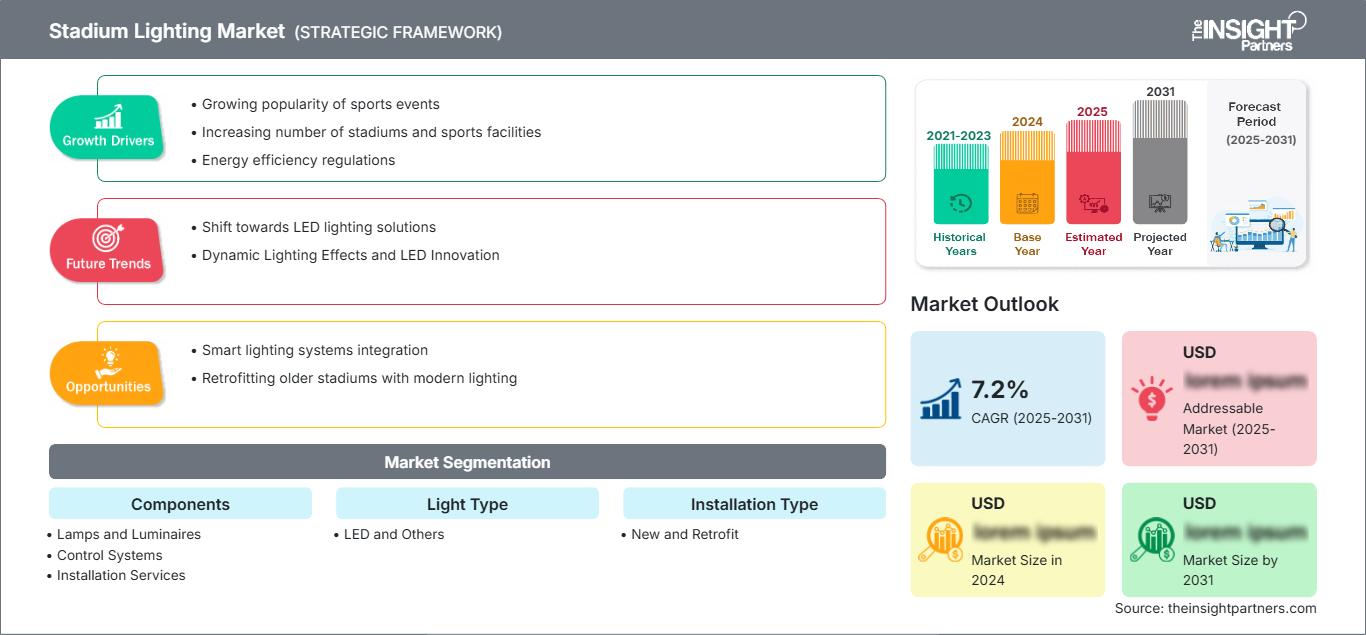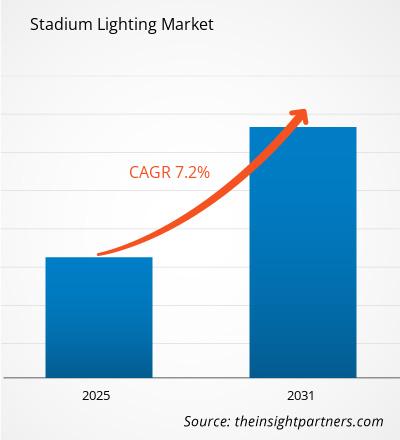Se espera que el mercado de iluminación de estadios registre una CAGR del 7,2 % entre 2025 y 2031, con un tamaño de mercado que se expandirá de US$ XX millones en 2024 a US$ XX millones en 2031.CAGR of 7.2% from 2025 to 2031, with a market size expanding from US$ XX million in 2024 to US$ XX Million by 2031.
El informe está segmentado por componentes (lámparas y luminarias, sistemas de control y servicios de instalación), tipo de iluminación (LED y otros), tipo de instalación (nueva y modernización) y aplicación (interior y exterior). El análisis global se desglosa a nivel regional y por países principales. El informe ofrece el valor en USD para el análisis y los segmentos mencionados.Luminaires, Control Systems, and Installation Services), Light Type (LED and Others), Installation Type (New and Retrofit), Application (Indoor and Outdoor). The global analysis is further broken-down at regional level and major countries. The report offers the value in USD for the above analysis and segments
Propósito del Informe
El informe "Mercado de Iluminación de Estadios" de The Insight Partners busca describir el panorama actual y el crecimiento futuro, los principales factores impulsores, los desafíos y las oportunidades. Esto proporcionará información a diversos actores del sector, como:
- Proveedores/fabricantes de tecnología: Para comprender la dinámica cambiante del mercado y conocer las oportunidades potenciales de crecimiento, lo que les permitirá tomar decisiones estratégicas informadas.
- Inversores: Realizar un análisis exhaustivo de tendencias respecto a la tasa de crecimiento del mercado, las proyecciones financieras del mercado y las oportunidades que existen en toda la cadena de valor.
- Órganos reguladores: Regular las políticas y las actividades policiales en el mercado con el objetivo de minimizar el abuso, preservar la confianza de los inversores y defender la integridad y estabilidad del mercado.
Segmentación del mercado de iluminación de estadios
Componentes
- Lámparas y luminarias
- Sistemas de control
- Servicios de instalación
Tipo de luz
- LED y otros
Tipo de instalación
- Nuevo y modernizado
Solicitud
- Interior y exterior
Obtendrá personalización en cualquier informe, sin cargo, incluidas partes de este informe o análisis a nivel de país, paquete de datos de Excel, así como también grandes ofertas y descuentos para empresas emergentes y universidades.
Mercado de iluminación de estadios: perspectivas estratégicas

-
Obtenga las principales tendencias clave del mercado de este informe.Esta muestra GRATUITA incluirá análisis de datos, desde tendencias del mercado hasta estimaciones y pronósticos.
Factores que impulsan el crecimiento del mercado de iluminación de estadios
- Creciente popularidad de los eventos deportivos: A nivel mundial, existe un creciente interés en los eventos deportivos, desde partidos locales hasta torneos internacionales, lo que impulsa la demanda de mejores infraestructuras para los estadios. Estas incluyen sistemas de iluminación avanzados que mejoran la experiencia del espectador, cumplen con los estándares de transmisión y permiten una mayor afluencia de público, impulsando así el crecimiento del mercado de soluciones de iluminación para estadios.
- Aumento del número de estadios e instalaciones deportivas: En este contexto, las inversiones en nuevos recintos deportivos y la modernización de los existentes, tanto en ciudades como en organizaciones, generaron una mayor demanda de sistemas de iluminación modernos. Desde estadios profesionales de vanguardia hasta campus universitarios, centros comunitarios e instalaciones multiusos, el mercado de todo tipo de productos de iluminación para estadios se amplió.
- Normativas de eficiencia energética: Los gobiernos de diversos países están imponiendo normas de eficiencia energética más estrictas para los edificios; las instalaciones deportivas no son la excepción. Esto, a su vez, aumenta la necesidad de soluciones de iluminación energéticamente eficientes, como los LED, lo que obliga a los operadores de estadios a actualizar sus sistemas de iluminación para cumplir con estas nuevas normas. Esto se traducirá en una mayor demanda de soluciones de iluminación eficientes para estadios.
Tendencias futuras del mercado de iluminación de estadios
- Transición hacia soluciones de iluminación LED: El mercado de la iluminación de estadios está adoptando rápidamente la tecnología LED, principalmente por su mayor eficiencia energética y vida útil. En comparación, los LED son más brillantes, ofrecen una mejor reproducción cromática y se encienden y apagan al instante, lo que resulta ventajoso para efectos de iluminación dinámicos y aplicaciones de radiodifusión.
- Efectos de iluminación dinámicos e innovación LED: Una tendencia destacada en el mercado de la iluminación de estadios es el uso de efectos de iluminación dinámicos, como LED que cambian de color y espectáculos de luces sincronizadas. Los estadios utilizan cada vez más sistemas de iluminación avanzados para crear espectáculos de luz visualmente atractivos que mejoran la experiencia de los aficionados y añaden emoción a los eventos. Estos sistemas pueden sincronizarse con la música, las reacciones del público o las actividades deportivas, creando entornos inmersivos para los aficionados. La creciente adopción de tecnologías LED avanzadas posibilita estas soluciones de iluminación creativas, ofreciendo nuevas formas de involucrar a los espectadores y realzar los eventos en vivo.
Oportunidades del mercado de iluminación de estadios
- Integración de sistemas de iluminación inteligente: La iluminación inteligente de estadios puede combinarse con opciones de control, energía y experiencia para el espectador. La función de visualización y ajuste remotos, así como la preprogramación o automatización, generará una nueva demanda de soluciones de iluminación sofisticadas y plataformas de software relacionadas.
- Modernización de estadios antiguos con iluminación moderna: La mayoría de los estadios existentes utilizan sistemas de iluminación menos modernos, lo que ofrece una gran oportunidad para modernizarlos. Esto no solo mejora la calidad de la iluminación, sino que también reduce los costos operativos, lo que genera un gran mercado para fabricantes de iluminación y servicios de instalación que se dedican a la renovación de estadios.
Perspectivas regionales del mercado de iluminación de estadios
Los analistas de The Insight Partners han explicado detalladamente las tendencias regionales y los factores que influyen en el mercado de iluminación de estadios durante el período de pronóstico. Esta sección también analiza los segmentos y la geografía del mercado de iluminación de estadios en América del Norte, Europa, Asia Pacífico, Oriente Medio y África, y América del Sur y Central.
Alcance del informe del mercado de iluminación de estadios
| Atributo del informe | Detalles |
|---|---|
| Tamaño del mercado en 2024 | US$ XX millones |
| Tamaño del mercado en 2031 | US$ XX millones |
| CAGR global (2025-2031) | 7,2% |
| Datos históricos | 2021-2023 |
| Período de pronóstico | 2025-2031 |
| Segmentos cubiertos |
Por componentes
|
| Regiones y países cubiertos |
América del norte
|
| Líderes del mercado y perfiles de empresas clave |
|
Densidad de actores del mercado de iluminación de estadios: comprensión de su impacto en la dinámica empresarial
El mercado de iluminación para estadios está creciendo rápidamente, impulsado por la creciente demanda del usuario final debido a factores como la evolución de las preferencias de los consumidores, los avances tecnológicos y una mayor conciencia de los beneficios del producto. A medida que aumenta la demanda, las empresas amplían su oferta, innovan para satisfacer las necesidades de los consumidores y aprovechan las tendencias emergentes, lo que impulsa aún más el crecimiento del mercado.

- Obtenga una descripción general de los principales actores clave del mercado de iluminación de estadios
Puntos clave de venta
- Cobertura integral: el informe cubre de manera integral el análisis de productos, servicios, tipos y usuarios finales del mercado de iluminación de estadios, proporcionando un panorama holístico.
- Análisis de expertos: el informe se compila con base en el conocimiento profundo de expertos y analistas de la industria.
- Información actualizada: El informe asegura relevancia comercial debido a su cobertura de información reciente y tendencias de datos.
- Opciones de personalización: este informe se puede personalizar para satisfacer los requisitos específicos del cliente y adaptarse adecuadamente a las estrategias comerciales.
Por lo tanto, el informe de investigación sobre el mercado de iluminación para estadios puede ayudar a descifrar y comprender el panorama del sector y sus perspectivas de crecimiento. Si bien existen algunas preocupaciones válidas, las ventajas generales de este informe suelen superar las desventajas.
- Análisis histórico (2 años), año base, pronóstico (7 años) con CAGR
- Análisis PEST y FODA
- Tamaño del mercado, valor/volumen: global, regional y nacional
- Industria y panorama competitivo
- Conjunto de datos de Excel
Informes recientes
Testimonios
Razón para comprar
- Toma de decisiones informada
- Comprensión de la dinámica del mercado
- Análisis competitivo
- Información sobre clientes
- Pronósticos del mercado
- Mitigación de riesgos
- Planificación estratégica
- Justificación de la inversión
- Identificación de mercados emergentes
- Mejora de las estrategias de marketing
- Impulso de la eficiencia operativa
- Alineación con las tendencias regulatorias






















 Obtenga una muestra gratuita para - Mercado de iluminación de estadios
Obtenga una muestra gratuita para - Mercado de iluminación de estadios